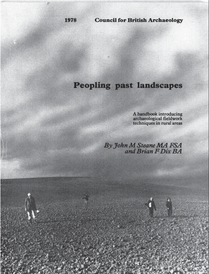CBA Occasional Papers
Council for British Archaeology, 2000. (updated 2013) https://doi.org/10.5284/1000333. How to cite using this DOI
Data copyright © Council for British Archaeology unless otherwise stated
This work is licensed under the ADS Terms of Use and Access.
Primary contact
Council for British Archaeology
92 Micklegate
York
YO1 6JX
UK
Tel: 01904 671417
Resource identifiers
- ADS Collection: 284
- DOI:https://doi.org/10.5284/1000333
- How to cite using this DOI
Peopling past landscapes. A handbook introducing archaeological fieldwork techniques in rural areas
John M Steane and Brian F Dix
CBA Occasional Papers No. 9 (1978)
ISBN 0 900312 81 5
Abstract

The Council for British Archaeology established its Schools Committee in April 1975 to advise on ways in which archaeology could become better understood in schools. Included among its initial studies were reviews of the various courses submitted in recent years to the Certificate of Secondary Education examining boards as well as surveys of the syllabuses leading to examination in archaeology at the ordinary and advanced levels of the General Certificate of Education. It soon became apparent, however, that many other school subjects borrow from the results of archaeology and such subjects are becoming increasingly involved in environmental work outside the classroom. There are also flourishing school archaeological societies engaged actively in fieldwork. Accordingly we thought it might be useful to attempt an explanation for schools of the accepted fieldwork techniques which archaeologists use in deciphering the various remains which constitute, for a number of periods, the sole record of man's past. The present handbook therefore describes those techniques used to gain an understanding of the physical remains of former human activity surviving in the countryside.
Although the handbook is primarily intended as an introductory study for teachers and those training for the profession, we hope that it will also be found useful by sixth-form students, people attending adult education courses in archaeology and local history, undergraduates, and young men and women attending professional training courses such as those administered by the Department of External Studies at the University of Oxford.
Contents
- Title pages
- Preface (pp 1-2)
- Introduction (pp 3-6)
- Preparation for fieldwork (pp 6-35)
- Planning a programme of fieldwork (pp 35-50)
- Carrying out fieldwork (pp 50-85)
- The recording and interpretation of fieldwork (pp 85-90)
- Useful books (pp 90-91)
- Useful addresses (p 92)
Download report
| Peopling past landscapes. A handbook introducing archaeological fieldwork techniques in rural areas (CBA Occassional Papers 9) | 4 Mb |







